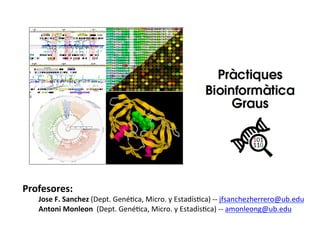Practica5 Bioinformatica
•
0 likes•139 views
Bioinformatica - Facultad Biologia - Universidad Biologia
Report
Share
Report
Share
Download to read offline

Recommended
More Related Content
Featured
Featured (20)
Product Design Trends in 2024 | Teenage Engineerings

Product Design Trends in 2024 | Teenage Engineerings
How Race, Age and Gender Shape Attitudes Towards Mental Health

How Race, Age and Gender Shape Attitudes Towards Mental Health
AI Trends in Creative Operations 2024 by Artwork Flow.pdf

AI Trends in Creative Operations 2024 by Artwork Flow.pdf
Content Methodology: A Best Practices Report (Webinar)

Content Methodology: A Best Practices Report (Webinar)
How to Prepare For a Successful Job Search for 2024

How to Prepare For a Successful Job Search for 2024
Social Media Marketing Trends 2024 // The Global Indie Insights

Social Media Marketing Trends 2024 // The Global Indie Insights
Trends In Paid Search: Navigating The Digital Landscape In 2024

Trends In Paid Search: Navigating The Digital Landscape In 2024
5 Public speaking tips from TED - Visualized summary

5 Public speaking tips from TED - Visualized summary
Google's Just Not That Into You: Understanding Core Updates & Search Intent

Google's Just Not That Into You: Understanding Core Updates & Search Intent
The six step guide to practical project management

The six step guide to practical project management
Beginners Guide to TikTok for Search - Rachel Pearson - We are Tilt __ Bright...

Beginners Guide to TikTok for Search - Rachel Pearson - We are Tilt __ Bright...
Practica5 Bioinformatica
- 1. Profesores: Jose F. Sanchez (Dept. Gené+ca, Micro. y Estadís+ca) -‐-‐ jfsanchezherrero@ub.edu Josep Tarragó (Dept. Bioq y Biomed. Molecular) -‐-‐ jtarragocelada@ub.edu
- 2. Bloque II
- 3. Bloque II
- 4. Genoteca DNA
- 5. Genoteca DNA
- 7. DNA – Transcript – mRNA -‐ CDS
- 8. DNA – Transcript – mRNA -‐ CDS NO!!! NO!!! NO!!! NO!!!
- 9. Operon
- 10. 2.2.2 Iden9ficació de bacteris • Dels resultats ob+nguts, quins són els valors més rellevants per decider aquesta similitud? • Quines són les seqüències que s'assemblen més a les de la seqüència del DNA 16S? • A quines espècies poden pertànyer aquestes seqüències I quin criteri podríem seguir per decidir-‐ho? • Quina funció tenen anotada les seqüències homologues a la base de dades? Seqüència DNA 16S del bacteri aïllat del sòl (amb ac+vitat carbohidratasa)
- 11. 2.2.2 Iden9ficació de bacteris
- 12. 2.2.2 Iden9ficació de bacteris Mínim 95% per considerar que dues seqüències pertanyen a una mateixa espècie
- 13. 2.2.2 Iden9ficació de bacteris
- 14. 2.2.3 Predicció de gens en seqüències anònimes Seqüència Gens? ORF? CDS? Translate tool EXPASY (genèrica) FgenesB (genomes bacterians) GLIMMER (procariotes) MIT genscan (eucariotes) Diverses eines: • Quantes ORFs trobem a cadascuna de les possibles pautes de lectura? • Quina és la longitud de les ORFs més llargues, a quina pauta de lectura s'han localitzat? • Quants CDS ens prediuen els diferents programes de predicció de gens, coincideixen tots ells per detector anotacions sobre les mateixes coordenades? • Perquè creieu que no ens podem refiar dels resultats ob+nguts amb el genscan? • Quantes i quines ORFs coincideixen amb les CDSs predates pels programes de predicció de gens?
- 15. 2.2.3 Predicció de gens en seqüències anònimes Translate tool EXPASY 1 forward 2 forward 3 forward 1 reverse 2 reverse 3 reverse
- 16. 2.1.3 Predicció de gens en seqüències anònimes FgenesB Massa pe+t BLAST
- 17. Translate tool EXPASY Si cliquem als dos ORFs llargs 1 forward 2 forward
- 18. 1 forward
- 19. 2 forward
- 20. 2.2.4 Cerca de senyals involucrats en la regulació dels gens
- 21. Procariotas vs. Eucariotas 2.2.4 Cerca de senyals involucrats en la regulació dels gens
- 22. 2.2.4 Cerca de senyals involucrats en la regulació dels gens
- 23. 2.2.4 Cerca de senyals involucrats en la regulació dels gens DBGP Promoter Predic9on (procariotes i eucariotes) SoWBerry BPROM (específic per a genomes bacterians)
- 24. DBGP Promoter Predic9on (procariotes i eucariotes) 2.2.4 Cerca de senyals involucrats en la regulació dels gens Gen Endogluconasa: Start 604 – End 3525 (+1) Gen Cel·∙lulosa 1,4-‐βcel·∙lobiosidasa: Start 3677 – End 6952 (+2)
- 25. SoWBerry BPROM (específic per a genomes bacterians) 2.2.4 Cerca de senyals involucrats en la regulació dels gens Gen Endogluconasa: Start 604 – End 3525 (+1) Gen Cel·∙lulosa 1,4-‐βcel·∙lobiosidasa: Start 3677 – End 6952 (+2)
- 26. 2.2.5 Clonació i expressió de gens
- 27. Vector de clonació: no de expressió
